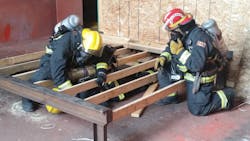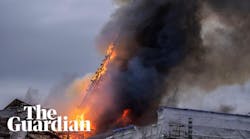“FireCom, E-2 on scene at 1234 Bowen Road. We have a two-story, Type 3 constructed commercial building with light smoke showing. E-2 will be Bowen Command. Stand by for an update.”
A 360 of the building is completed, and two members from E-2 are designated as Attack 1. Attack 1 is assigned to locate the fire via a right-hand search along with coordinated ventilation. E-1 arrives on scene, and two members are designated as RIT 1 and directed to set up RIT at the A/B corner of the building.
The RIT pack and kit are grabbed off of the nearest engine, and RIT 1 proceeds to set up RIT on the A/B corner. Rescue tools are placed on the RIT tarp, and with RIT board in hand, the RIT team begins its own 360 of the building looking for a second means of egress and possible hazards. One member of the team is designated as RIT leader and will be in charge of communications.
“Mayday, mayday, mayday!” is heard across the fireground. “Mayday received go ahead,” answers Command. “Command this is Firefighter Evans, Attack 1. We have had a wall collapse on the first floor, and Firefighter Smith is unconscious and trapped. He’s got 750 psi of air remaining. Need help to extricate. Conditions are deteriorating.”
“Command copies Attack 1. Activating RIT.”
This is a worst nightmare for an incident commander (IC). Thankfully, what you have just read is a scenario from the Nanaimo Fire Rescue’s Rapid Intervention Program, which takes place at a vacant industrial complex in Nanaimo, British Columbia, Canada.
NFR advocate groups
Located on the west coast of Canada on Vancouver Island, Nanaimo Fire Rescue (NFR) is a combination department consisting of 81 career operations staff and four career stations staffed 24/7.
As part of the ongoing professional development at NFR, staff members are encouraged to get involved with one of several advocate groups in the department. Members of these groups become the subject-matter experts in the department. With support from management, these members research best practices in training, develop lesson plans, implement programs and assist with the writing and review of operational guidelines.
The RIT program is one of the great success stories that has come out of the advocate groups at Nanaimo Fire Rescue.
RIT regulation
WorkSafe BC, the Occupational, Safety and Health (OSH) regulator in British Columbia, sets standards for firefighting in the province. With regards to RIT teams, Section 31.23 of the OHS Regulation states:
(1) When self-contained breathing apparatus must be used to enter a building, or similar enclosed location, the entry must be made by a team of at least two firefighters.
(2) Effective voice communication must be maintained between firefighters inside and outside the enclosed location.
(3) During the initial attack of an incident, at least one firefighter must remain outside.
(4) A suitably equipped rescue team of at least two firefighters must be established on the scene before sending in a second entry team and not more than 10 minutes after the initial attack.
(5) The rescue team required by subsection (4) must not engage in any duties that limit their ability to make a prompt response to rescue an endangered firefighter while interior structural firefighting is being conducted.
Developing the program
In 2009, a senior officer and 10-year firefighter set out to develop a training program based on self-survival for firefighters. Little did he know that from that basic start, the program would develop into an extensive, three-part training program consisting of in-house built props that replicate real-life situations and enhance the training experience.
All of this could not have been possible without the dedication of the current and previous advocate group members and especially Lt. Troy Libbus. Lt Libbus was an original member of the RIT advocate group and was instrumental in the development of the program. Lt. Libbus has spent countless hours on and off shift focusing on the research, development and training of members in the department. When asked why he has dedicated so much time to this effort, Lt. Libbus stated, “As a rapid intervention instructor with Nanaimo Fire Rescue, I find that RIT incorporates many firefighting-related skills in one discipline. Nanaimo Fire Rescue RIT scenarios are designed to challenge members to think, plan and act in very difficult situations. It is a privilege to have the opportunity to give back to this department.”
Considering the quality of the program developed, buy-in from the members has been exceptional. The program has been very well received by all operations staff and has been regarded as some of the finest training the staff has taken. This speaks volumes about the quality of content that the advocates have produced.
Fire Chief Craig Richardson adds, “I am so proud of the members that developed this program. It’s part of our philosophy to enable members to drive critical initiatives in the department. They are leaders at all levels."
4-Part Program
The RIT program at NFR is divided into four parts: Self-Survival, RIT 1, RIT 2 and the recently added RIT Maintenance. It was decided early on that PowerPoint presentations and classroom time would be kept to a minimum and used only to provide an overview of the training topics. Practical hands-on training would take up a majority of time during the lessons.
Part 1: Self-Survival
The Self-Survival section prepares firefighters with the tools and information needed in the event that they become lost or trapped at an incident. This information can enhance their chance of rescue and/or survival. Topics discussed in this section include:
- 10 steps to self-survival
- Understanding the difference between mayday and emergency traffic, and when to use both
- Effective radio communications
- Applying escape tactics
- Importance of self-control in stressful situations
Practical training for self-survival begins with a member crawling through the entanglement prop with a smoked-out mask. Once members make it through the entanglement section, they then have to either breach a wall to get out to a safe area or exit the prop by climbing through a window. All operations staff members are taught different skills to free themselves in the event of an entanglement prior to entering the prop. All drills are practiced in full turnout gear, SCBA and while breathing air.
Communications are conducted via department radios, and members must adhere to best practices for radio use.
Part 2: RIT 1
The second part of our program, RIT 1, looks at the why, when and what aspects of RIT. Topics covered include:
- What is RIT?
- Why and when RIT is needed
- RIT team leader qualifications
- Required equipment
- Responsibilities of RIT
- How RIT is activated
One full day of practical training is involved with RIT 1, with the morning session consisting of:
- Different uses and applications of our RIT pack
- Donning of the RIT pack onto a downed firefighter and the various steps involved prior to patient removal
- Numerous firefighter rescue drags and carries
The afternoon of training consists of tying it all together with a RIT rescue scenario in an unoccupied, commercial building in the downtown core. (NFR has used various buildings throughout the city in our training programs and built good relationships with our community partners. Notifications are always given to property owners prior to and at the end of training sessions.)
Three training scenarios take place in the afternoon and begin with the engine rolling up on scene and broadcasting an on-scene report. Crews then enter the building, looking for the seat of the fire, when one of the following happens:
- One firefighter goes down with an apparent heart attack and his/her partner has to call mayday.
- One firefighter is injured and requires assistance out. Partner panics and exits out the building, leaving him behind. Mayday is broadcast.
- Two-member attack team gets separated, and one firefighter can’t find their way out and broadcasts a mayday. RIT is activated and a rescue is performed.
Part 3: RIT 2
Topics covered in the third section, RIT 2, include:
- Understanding contributing factors to early injury and death
- Building construction and classification review
- ICS action plan
- Additional rescue techniques
The main focus in this section is to understand why firefighters are getting hurt and what we can do on the fireground to prevent injuries. All practical training in this section takes place in an abandoned industrial paint booth that has been certified safe by our OHS department. Inside the building, a two-story prop has been constructed that contains:
- An air assisted collapsing floor section
- A second-floor removable hatch where a rescue can be facilitated from
- Reusable wall collapse
- Confined space practice area
One of the unique areas of the prop is the collapsing floor section. This section is operated by the instructor and controlled by air pressure. The air pressure controls the rate of decent in order to prevent injury to the firefighter while at the same time not allowing him/her to move off the section. Foam mats are also placed underneath the collapsing section as added protection. We always strive for realistic training at NFR but not at the expense of our firefighter’s health.
Attached to the prop is a collapsible wall section that is designed to accommodate a downed firefighter being placed underneath replaceable, wooden wall studs. The RIT team is required to extricate the trapped firefighter by breaking, cutting or removing these wall studs. The prop was designed so that the studs are easily replaced after each drill. RIT teams are allowed to use any tools that are available to them on the engines or rescue trucks and are encouraged to use different tools each time.
There are two RIT 2 scenarios:
- Firefighter falls through the floor and ends up in the basement. A horseshoe rescue (loop created with a handline to lift a firefighter from a sublevel) is performed to extricate the firefighter.
- Two firefighters experience a wall collapse and one of them is knocked unconscious and trapped under the wall. Subsequently, the second firefighter is injured and unable to assist his partner.
Part 4: RIT Maintenance
Members of the RIT advocate group did not want to see all the valuable information and training that had taken place with the first three sections of the RIT program be forgotten, and decided that a yearly maintenance program would assist our firefighters with their skill maintenance. The maintenance program consists of the following:
- PowerPoint presentation that covers various articles from Firefighter Close Calls and how they relate to rapid-intervention teams
- A self-survival review that covers the following: proper radio techniques, 10 steps to self survival, mayday and emergency traffic, entanglement procedures, and firefighter drags and carries
- Review of RIT packs
- Scenarios (advocates are currently developing new scenarios for the maintenance section of the program)
In sum
The RIT program at NFR continues to evolve as new and exciting training material is added. We hope that we never have to deploy RIT at an incident, but understand that we still have to train to be ready. Being a member of a RIT team at an incident is an important position. We must be prepared and ready to act at a moment’s notice. Officers need to take into account how fire behaves with the materials used in modern manufacturing and how quick a fire can reach flashover. We need to know when to stop sending firefighters into buildings when we know occupant survival is nonexistent.
Having a RIT on standby does not allow us to take unnecessary risks on the fireground. A RIT team is there when we have taken all of the necessary precautionary measures and still something unforeseen happens. Let’s keep everyone safe out there.






